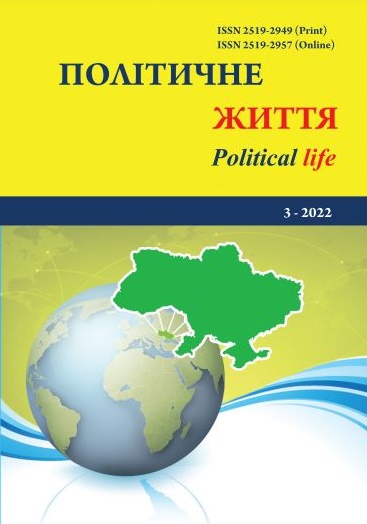Crisis Narrative Construction in Ukrainian Media During the Full-Scaled Invasion of the Russian Federation
DOI:
https://doi.org/10.31558/2519-2949.2022.3.13Keywords:
full-scale invasion of the Russian Federation; crisis narrative; Ukrainian mass media; content analysis; natural language processingAbstract
The full-scale invasion of the Russian Federation was a reason to construct a crisis narrative by Ukrainian political actors. The key issues for the narrative were not only the reasons for the invasion, but Ukraine’s readiness for it, as well as the ability to resist the Russian occupation. It’s additionally important to consider the constant attacks of Kremlin propaganda on Ukrainian public opinion and attempts to undermine the narrative proposed by the military-political leadership. In this context, it is relevant to monitor the crisis narrative as it appears in the mass media. The purpose of this study is to observe the construction of the crisis narrative through the analysis of the functions of the leading political actors (narrators) in it. Research material: news publications of «Ukrayins`ka pravda». Period: January – June 2022. Methods: content analysis, as well as modified narrative analysis based on NLP – natural language processing. The collection of material, as well as its processing was possible with the help of computer programs (Python language). It was found that attention to the leading political actors indicates that the media narratives before the invasion, during the first and second phases were changing. The significant presence of Ukrainian political actors in the media indicates that it was they who shaped these narratives. It was revealed that in January-February, attention was focused on internal events, and the threat of invasion was considered unlikely. Instead, in March-April, most hopes were placed on the help of the West and Western leaders, who were supposed to stop Russia. However, already in May-June, internal Ukrainian political actors came forward, which indicated a desire to act independently, and the very idea of «appeasement» with Russia was mostly rejected. Kuleba, Zelensky and Biden were the most popular speakers. Instead, attention to Macron’s quotes decreased over time, and Putin’s words were almost not of interest to the media at all. As for the more specific roles of political actors, Zelenskyi and Kuleba were the leading storytellers shaping Ukrainian crisis narrative.
References
Anderson L. (2018). Leadership during Crisis Navigating Complexity and Uncertainty. Leader to leader. DOI:10.1002/ltl.20389
Bennett W. L., Pfetsch B. (2018). Rethinking Political Communication in a Time of Disrupted Public Spheres, Journal of Communication. 68 (2). 243–253. DOI:10.1093/joc/jqx017
Bernard N. R. et al. (2021). Analysis of crisis communication by the Prime Minister of Australia during the COVID-19 pandemic. International Journal of Disaster Risk Reduction. 62. DOI: 10.1016/j.ijdrr.2021.102375.
Boin A. (2019). The transboundary crisis: Why we are unprepared and the road ahead. Journal of Contingencies and Crisis Management. 27(1). 94–99
Boin A., ‘t Hart P., Stern E., Sundelius B. (2016). Meaning Making: Constructing a Crisis Narrative. In The Politics of Crisis Management: Public Leadership under Pressure (pp. 78-101). Cambridge: Cambridge University Press. DOI:10.1017/9781316339756.005
Clementson D. Xie, T. (2020). Narrative storytelling and anger in crisis communication. Communication Research Reports. 37. 1-10. DOI: 10.1080/08824096.2020.1811660.
Coombs W.T. (2007). Protecting Organization Reputations During a Crisis: The Development and Application of Situational Crisis Communication Theory. Corporate Reputation Review. 10(3), 163-177.
Dayan D., Grant P. (2005). The Pope at reunion: hagiography, casting, and imagination. In E. W. Rothenbuhler, M. Coman (Eds.), Media anthropology (pp. 165-175). Thousand Oaks: SAGE Publications, Inc. DOI:10.4135/9781452233819.n16
de Clercy C., Ferguson P. (2016). Leadership in Precarious Contexts: Studying Political Leaders after the Global Financial Crisis. Politics and Governance. 4 (2). URL: https://www.cogitatiopress.com/politicsandgovernance/article/view/582
Heath R. L., Millar D. P. (2004). A Rhetorical Approach to Crisis Communication: Management, Communication Processes, and Strategic Responses. In D. P. Millar, R. L. Heath – eds. Responding to Crisis A Rhetorical Approach to Crisis Communication. Abingdon-on-Thames: Routledge.
Krzyżanowski, M. (2019). Brexit and the imaginary of ‘crisis’: a discourse-conceptual analysis of European news media. Critical Discourse Studies. 16(4). 465-490, DOI: 10.1080/17405904.2019.1592001
Millar D.P., Heath R.L. (2003). Telling a Story: A Narrative Approach to Communication During Crisis. Abingdon: Routledge.
Moffitt, B. (2015). How to Perform Crisis: A Model for Understanding the Key Role of Crisis in Contemporary Populism. Government and Opposition. 50(2). 189-217. DOI:10.1017/gov.2014.13
Pfetsch, B. (1999). Government news management-strategic communication in comparative perspective. WZB Discussion Paper. No. FS III 99-101.1-42. URL: https://www.econstor.eu/bitstream/10419/49821/1/30895761X.pdf
Seeger M., Sellnow T. L. (2016). Narratives of Crisis: Telling Stories of Ruin and Renewal. Stanford: Stanford University Press.
Tornero, J.M., Lladó С. M., Cervi L. (2021). Pandemic and war: crisis narrative and leadership. Analysis of the presidential speeches at the beginning of the COVID-19 pandemic. Revista Latina de Comunicación Social. 79. P. 1-21. DOI:10.4185/RLCS-2021-1500
Valdivia P. (2019). Narrating crises and populism in Southern Europe: Regimes of metaphor. Journal of European Studies. 49(3-4). 282-301. DOI:10.1177/0047244119865083

